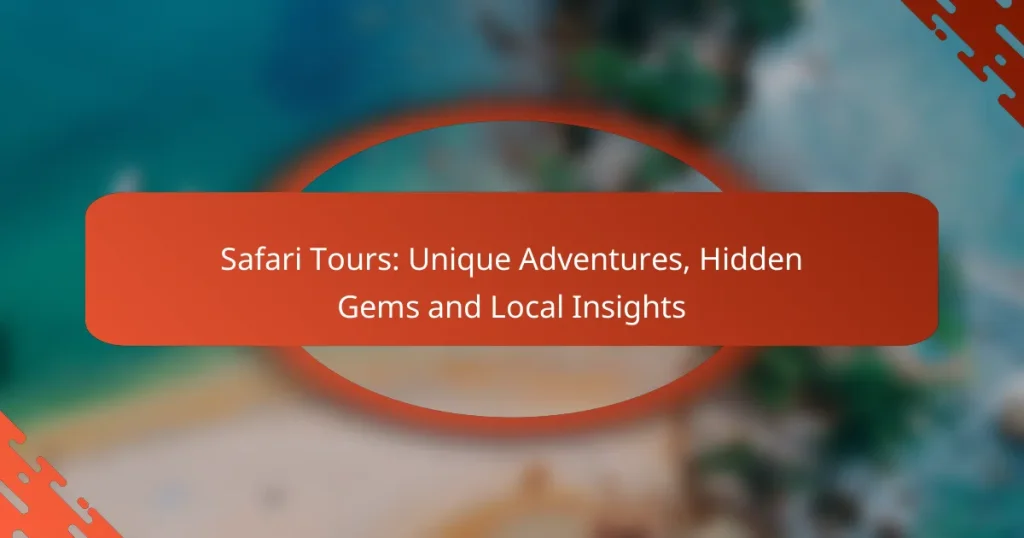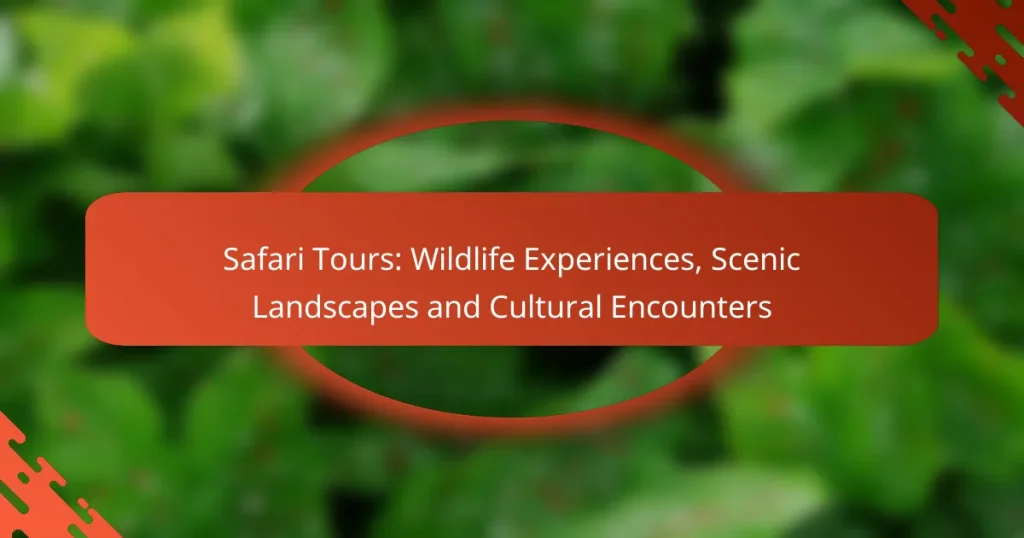Embarking on a safari tour is an unforgettable way to experience the breathtaking wildlife and landscapes of Africa. With top destinations like Tanzania, Kenya, South Africa, Botswana, and Namibia, each offers unique opportunities to witness animals in their natural habitats. When planning your safari, it’s essential to consider your budget, trip duration, and desired experiences to ensure a rewarding adventure.
Safari Tours: Unique Adventures, Hidden Gems and Local Insights
Safari Tours: Family-Friendly Activities, Accommodations and Safety
Safari Tours: Photography Opportunities, Golden Hour and Scenic Views
Safari Tours: Wildlife Concentration, Biodiversity and Ecosystem Health
Safari Tours: Wildlife Experiences, Scenic Landscapes and Cultural Encounters
Kenya vs. Tanzania: Which Is Better and When to Use
What are the best safari tour destinations in Africa?
The best safari tour destinations in Africa offer diverse wildlife experiences and stunning landscapes. Popular locations include Tanzania, Kenya, South Africa, Botswana, and Namibia, each providing unique opportunities to observe animals in their natural habitats.
Serengeti National Park, Tanzania
Serengeti National Park is renowned for its vast savannahs and the Great Migration, where millions of wildebeest and zebras traverse the plains. Visitors can expect to see a variety of wildlife, including lions, elephants, and cheetahs, making it a prime location for game drives.
When planning a visit, consider the timing of the migration, which typically occurs between June and October. Accommodations range from luxury lodges to budget camps, catering to different preferences and budgets.
Masai Mara National Reserve, Kenya
The Masai Mara National Reserve is famous for its rich wildlife and cultural experiences with the Maasai people. It is a prime location for spotting the Big Five: lions, leopards, elephants, buffalo, and rhinoceros.
Safari options include guided game drives and hot air balloon rides, offering unique perspectives of the landscape. The best time to visit is during the dry season from July to October, coinciding with the migration from the Serengeti.
Kruger National Park, South Africa
Kruger National Park is one of Africa’s largest game reserves, known for its extensive road network and self-drive safari options. It hosts a wide variety of wildlife, including the Big Five, and offers numerous accommodations ranging from campsites to luxury lodges.
Visitors should consider purchasing a park map and planning their routes in advance to maximize wildlife sightings. The park is open year-round, but the dry winter months from May to September are ideal for viewing animals congregating around water sources.
Chobe National Park, Botswana
Chobe National Park is famous for its large elephant population and diverse ecosystems, including rivers, floodplains, and woodlands. Boat safaris along the Chobe River provide excellent opportunities to see wildlife, especially during the dry season.
When visiting, consider a combination of boat and land safaris to experience the park fully. The best time to visit is during the dry months from May to October, when animals are more easily spotted near water sources.
Etosha National Park, Namibia
Etosha National Park is characterized by its salt pans and unique wildlife viewing opportunities. The park is home to a variety of species, including black rhinos, giraffes, and numerous bird species, making it a great destination for wildlife enthusiasts.
Visitors can explore the park via self-drive or guided tours, with several waterholes providing excellent viewing spots. The dry season from May to October is the best time for wildlife sightings as animals gather around these water sources.
What should I consider when choosing a safari tour?
When selecting a safari tour, consider your budget, the duration of the trip, the type of experience you desire, and the wildlife viewing opportunities available. Each of these factors will significantly influence your overall satisfaction and the value you receive from the tour.
Budget and pricing options
Safari tours can vary widely in cost, typically ranging from a few hundred to several thousand dollars per person. Factors affecting pricing include the level of luxury, included amenities, and the destination. Budget options may include camping safaris, while luxury tours often feature high-end lodges and exclusive experiences.
It’s essential to clarify what is included in the price, such as meals, park fees, and transportation. Look for transparent pricing to avoid unexpected costs.
Duration of the tour
The duration of safari tours can range from a couple of days to several weeks. Shorter tours may focus on specific parks or reserves, while longer trips allow for a more comprehensive exploration of multiple regions. Consider how much time you have available and what you hope to see.
For first-time safari-goers, a 5 to 7-day tour is often ideal, providing ample time for wildlife viewing without overwhelming travel schedules.
Type of safari experience
There are various types of safari experiences, including game drives, walking safaris, and boat safaris. Game drives are the most common, offering a chance to see wildlife from a vehicle, while walking safaris provide a more intimate connection with nature.
Choose the type of experience that aligns with your interests and comfort level. For example, if you prefer a more active adventure, a walking safari might be suitable, whereas families with young children may opt for traditional game drives.
Wildlife viewing opportunities
Different safari destinations offer unique wildlife viewing opportunities, so research the types of animals you want to see. For instance, the Serengeti in Tanzania is famous for the Great Migration, while Kruger National Park in South Africa is known for its diverse wildlife.
Check the best times to visit each destination for optimal wildlife sightings. Many parks have peak seasons when animal activity is higher, often correlating with dry seasons or migration patterns.
How much do safari tours cost?
The cost of safari tours varies widely based on factors such as location, duration, and level of luxury. On average, travelers can expect to spend anywhere from a few hundred to several thousand dollars per day, depending on their preferences and the specific experiences offered.
Average cost per day
The average cost per day for a safari tour typically ranges from around $150 to $500 per person. Budget options may start at the lower end, while mid-range and luxury tours can significantly increase the price. Factors influencing daily rates include accommodation type, meal plans, and the inclusion of guided tours.
For example, a budget camping safari in East Africa might cost about $150 per day, while a luxury lodge experience could exceed $1,000 per day. It’s essential to consider what is included in the price when comparing options.
Luxury vs budget safari pricing
Luxury safaris often feature high-end accommodations, gourmet meals, and exclusive experiences, leading to prices that can soar into the thousands per day. In contrast, budget safaris typically offer basic lodging and fewer amenities, making them more accessible for travelers on a tighter budget.
For instance, a luxury safari in South Africa may cost between $800 and $2,500 per day, while budget options could be available for $150 to $300. Understanding your priorities and what you wish to experience can help guide your choice between luxury and budget options.
Included services and fees
When evaluating safari tour costs, it’s crucial to consider what services and fees are included. Many packages cover accommodations, meals, park entrance fees, and guided tours, but some may charge extra for activities like hot air balloon rides or private guides.
Common inclusions in safari packages are transportation to and from the airport, game drives, and sometimes even laundry services. Always read the fine print to avoid unexpected costs and ensure you understand what is part of your package before booking.
What are the best times to go on a safari?
The best times to go on a safari generally depend on the specific destination and the wildlife you wish to see. However, many travelers find that visiting during the dry season offers optimal wildlife viewing opportunities due to reduced vegetation and animals congregating around water sources.
Peak wildlife viewing seasons
Peak wildlife viewing seasons typically occur during the dry months, which vary by region. For example, in East Africa, the dry season runs from June to October, while Southern Africa’s peak season is from May to September. During these times, animals are easier to spot, as they gather near waterholes.
Additionally, the Great Migration in Tanzania and Kenya attracts many visitors from July to September, making it an exceptional time for wildlife enthusiasts. Booking well in advance is advisable during these peak periods due to high demand.
Weather considerations
Weather plays a crucial role in safari experiences. The dry season generally offers clear skies and comfortable temperatures, making it ideal for game drives. Conversely, the wet season, while lush and vibrant, can lead to muddy roads and limited visibility.
Travelers should also consider the local climate; for instance, temperatures can vary significantly between day and night in some regions. Packing layers is recommended to adapt to these changes throughout the day.
Off-peak advantages
Traveling during the off-peak season can provide several advantages, including lower prices and fewer tourists. This can lead to a more intimate experience with wildlife and a greater chance of personalized service from guides.
However, visitors should be aware that wildlife sightings may be less predictable during this time. Rainy conditions can also affect accessibility to certain areas, so planning ahead is essential to maximize the experience.
What gear should I bring on a safari?
When preparing for a safari, it’s essential to pack gear that enhances your experience and ensures comfort. Key items include appropriate clothing, photography equipment, and personal essentials tailored to the environment.
Essential clothing items
Your clothing should be lightweight, breathable, and suitable for varying temperatures. Neutral colors like khaki, beige, or olive green are recommended to blend in with the surroundings and avoid startling wildlife.
Consider packing long-sleeved shirts and long pants to protect against sunburn and insect bites. A wide-brimmed hat and sunglasses are also crucial for sun protection, while a light jacket or fleece can be helpful for cooler evenings.
Photography equipment recommendations
For capturing the beauty of wildlife, a good camera with a zoom lens is vital. A lens with a focal length of at least 200mm is recommended to get close-up shots without disturbing animals.
Additionally, bring extra batteries and memory cards, as you may spend long hours in the field. A sturdy tripod or monopod can help stabilize your shots, especially in low-light conditions during dawn or dusk.






